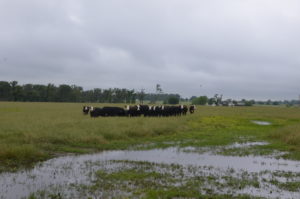Expert: Few options to salvage late-season hay amid wet weather
- Writer: Adam Russell, 903-834-6191, [email protected]
- Contact: Dr. Vanessa Corriher-Olson, 903-834-6191, [email protected]
OVERTON – Warm-season grasses are plentiful in hay producing areas, but the rain that helped improve growing conditions following an extended period of drought is hurting their chances for more round bales, said a Texas A&M AgriLife Extension Service expert.

Dr. Vanessa Corriher-Olson, AgriLife Extension forage specialist, Overton, said late-season rains created good growing conditions for warm-season grasses over the last 60 days following months of drought that left hay supplies low around the state.
She said while grasses might be abundant in pastures and hay meadows, producers are having difficulty harvesting between rains.
Corriher-Olson said many producers are counting on a final cutting, but weather conditions have been against them as the first freezing temperatures rapidly approach.
Producers would ideally make the final cutting now when the grass is green and before the first frost, which typically occurs Nov. 15 in East Texas, she said, but continuous rains over the last 60 days have allowed few opportunities for producers to harvest.
“Accessing the pastures with equipment was a problem, but even once the ground dried out enough to get in, producers had to consider if there was a window between rains where the hay could be cut, cured and baled before another rain,” she said. “It’s been difficult, and producers need the hay.”
Corriher-Olson said producing hay bales is heavily dependent on weather and there are risks associated with any decision when it comes to harvesting hay at this point in the season amid unfavorable weather conditions.
The best option is to move cattle onto the field for grazing if there is fencing and water is available.
“Livestock are much better harvesters than we are with machines,” she said. “But grazing isn’t an option for a lot of producers because many East Texas hay meadows don’t have fences or water.”
If hay is cut and remains on the ground when it rains, Corriher-Olson said it will begin to lose nutritive value due to leaching of non-structural carbohydrates. Rain can also shatter leaves off harvested forage and reduce both the crude protein and energy levels of the hay.
Harvesting hay after a frost is an option, she said. However, producers still need to be cautious of weather conditions.
“With cooler temperatures and cloudy days, curing hay can be even more challenging,” she said.
Extra forage can also be allowed to remain standing in the field for grazing, Corriher-Olson said. Maintaining some substantial Bermuda grass or Bahia grass stubble height could provide shade that could reduce volunteer ryegrass as well as other weed seed germination.
This might not provide 100 percent control, however competition can help reduce undesired plant growth, she said. Maintaining a higher stubble height can also be beneficial for the future growth of warm-season perennials. Higher stubble height means more substantial root structure to capture deeper soil moisture and nutrients.
“Cooler spring temperatures, drought, fall armyworms and late fall rains have added extra challenges for hay production, so late season utilization, whether harvesting, grazing or maintaining stubble, could impact forage production this year and next,” she said.


